 “Nothing can hurt us now. What we have can’t be destroyed. That’s our victory, our victory over the dark.” — Bette Davis to George Brent
“Nothing can hurt us now. What we have can’t be destroyed. That’s our victory, our victory over the dark.” — Bette Davis to George Brent
Dark Victory was among ten nominees for the Best Picture of 1939. At least that number had been standard since 1932-33, a “year” when the new film period would run seventeen months from August 1, 1932, to December 31, 1933, so that future Oscars could be awarded for a calendar year. Fewer contenders, however, would not have helped Dark Victory. At any other time, the film would be regarded as relatively strong, and even today, in retrospect, and as an example of Hollywood’s Golden Age, it remains just that.
But this is, after all, 1939, movie history’s greatest year. In simple fact, Dark Victory is outshone by all but one or two of its ten competitors. What a list: Mr. Smith Goes to Washington, Wuthering Heights, Stagecoach, Goodbye, Mr. Chips, The Wizard of Oz, Ninotchka, Of Mice and Men and—what was that other little flick?—oh, yes: Gone With the Wind. The diversity in the kinds of films is amazing! The tenth film, Love Affair, is similar to Dark Victory in worth and is also a “downer,” though fewer hankies are needed to watch it.
But Dark Victory was a big success at the time, making money and pleasing the legion of [intlink id=”603″ type=”category”]Bette Davis[/intlink]’ women fans, for it definitely is a woman’s picture. Not only was this Bette’s all-time favorite movie, 1939 was her best year: never again would she have four releases in a single year, nor, to accompany Dark Victory, films of such quality as Juarez, The Old Maid and The Private Lives of Elizabeth and Essex. (True, 1932 was her most prolific year, with nine films released, but how many are remembered! Well, maybe The Man Who Played God and Cabin in the Cotton.)
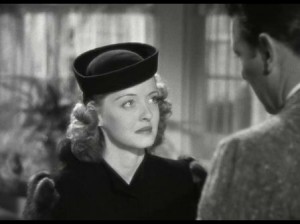 Davis was at the top of her game in 1939. Still able to play “young” at thirty-one, she would never look more girlish, especially in the early part of Dark Victory; throughout, she was able to transfer that persona to her character—vivacious, wide-eyed and, at the same time, surprisingly subtle for Davis.
Davis was at the top of her game in 1939. Still able to play “young” at thirty-one, she would never look more girlish, especially in the early part of Dark Victory; throughout, she was able to transfer that persona to her character—vivacious, wide-eyed and, at the same time, surprisingly subtle for Davis.
As the young—there’s that word again—free-living socialite doomed to die in eight months or so from an incurable brain tumor, Davis as Judith Traherne runs a carefully gauged range of ups and downs, an elaborate version of the psychological stages dying individuals experience: carefree ignorance, gnawing suspicion that something is wrong, then reverse denial that anything is wrong, happiness that the operation was a success, resentment and depression that she was lied to and that she will die, then quiet acceptance and, finally, courageous last moments. Davis takes full advantage of each emotion along the way, yet curving her tendency to overact, softening her voice and bringing tuned nuance to each phase, becoming a likeable and sympathetic character.
Oh, sure, there are still the Davis mannerisms that, however strong her ability as an actress, she was never able to overcome, no more than any actors, however good or great, can step totally outside of themselves. If Bette, somehow, were able to do so, most regrettably, there would no longer be a Bette Davis. The clenching and unclenching of the fingers, their fidgeting clasp of objects, is perhaps the most obvious of the persistent Davisian mannerisms, which is carried to annoying extremes in Elizabeth and Essex.
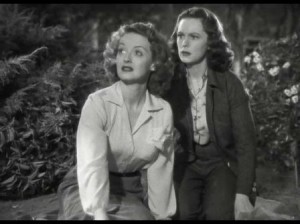 Within the context of the Dark Victory story, however, hands are important and symbolic. In the beginning, when her illness is being diagnosed, she has no feeling in her right hand and can’t identify objects with her eyes closed; in the end, when the illness has returned and she is within hours of death, she can now, by contrast, feel the sun’s warmth on both her hands. The only symptom now is her going blind. During this emotional journey, she often looks at her hands, wrings or caresses them and holds objects with an appreciation of touch that hadn’t been there before.
Within the context of the Dark Victory story, however, hands are important and symbolic. In the beginning, when her illness is being diagnosed, she has no feeling in her right hand and can’t identify objects with her eyes closed; in the end, when the illness has returned and she is within hours of death, she can now, by contrast, feel the sun’s warmth on both her hands. The only symptom now is her going blind. During this emotional journey, she often looks at her hands, wrings or caresses them and holds objects with an appreciation of touch that hadn’t been there before.
The determined, usually jerky Davis walk persists, as does the way she stands, how she leans back, hands on hips, the abrupt movements of her head. In even the subdued scenes, a nervous, kinetic energy simmers beneath the surface. But that’s Bette Davis.
In the movie are a lot of the star’s favorite people, who undoubtedly contributed to making this her favorite film. Her favorite and most frequent cinematographer, Ernest Haller (listed as “Ernie” in the credits), is the master of the gauze that softens the advancing years of a number of aging actresses, later to include Davis. He was there for her first Oscar win, Dangerous, and for her second, Jezebel; and for a number of her unsuccessful nominations—The Letter, Mr. Skeffington and for her last in 1962, Whatever Happened to Baby Jane?
Max Steiner, who here produces one of his more subtle scores, one without the usual musical borrowings and dramatic flag-waving, is her favorite composer. As well, Steiner seems to have largely avoided—I’d have to watch the film again to guarantee this—one of his favorite devices, the stinger chord, for, God knows, there are plenty of opportunities to use it, for the progressively darker revelations in Judith’s life.
With only a piano, celesta, vibraphone and a single harp, he ingeniously creates music to denote Judith’s blindness. (Though how well, really, is music capable of representing something as abstract as blindness?) Darker tones convey her illness and chromatic strings her more positive acceptance of her fate. “I always have to laugh a little,” Davis said in a 1971 David Frost TV program, “ . . . because there was really no need for Judith to die, because my beautiful Max Steiner did it for me. Even before I got on the bed, the angels were singing!” The “angels” were a wordless chorus, with, before that, a suggestion of “Ave Maria” in the orchestra.
At the other end of the emotional spectrum—gaiety and optimism—there is Steiner’s “happy” music for the wintry Vermont scenes where Judith spends her happiest days with the man she loves. (Here, as with storms, chaos and love, music is a far better messenger.) As film music scholar Tony Thomas wrote, “[Steiner] could write catchy, happy themes with a deftness that was the envy of his colleagues . . . ”
Steiner, whose first score for a Davis film was the long-forgotten Way Back Home (1931) at RKO, would score some of her best and most typical Warner Brothers films: Jezebel, The Letter, The Old Maid, All This and Heaven, Too and, perhaps most typical, Now, Voyager, and, unintentionally, a few of her weakest.
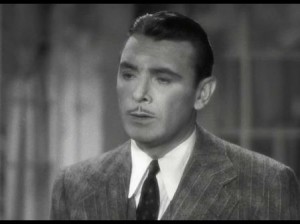 The last of these favored artists gather around her is [intlink id=”1483″ type=”category”]George Brent[/intlink] as Dr. Frederick Steele. He played opposite Davis in eleven films, on a few occasions other than her leading man. Brent, who was not essentially a dynamic actor and devoid of histrionics—Hamlet, for example, would be beyond him—was not one of Davis’ four husbands, though the two did have a two-year affair.
The last of these favored artists gather around her is [intlink id=”1483″ type=”category”]George Brent[/intlink] as Dr. Frederick Steele. He played opposite Davis in eleven films, on a few occasions other than her leading man. Brent, who was not essentially a dynamic actor and devoid of histrionics—Hamlet, for example, would be beyond him—was not one of Davis’ four husbands, though the two did have a two-year affair.
Nor is Brent the typical leading man in Dark Victory, for the few kisses are, indeed, feeble. In the beginning he is the concerned doctor, even a father figure; in the later part of the film he becomes the stalwart, low-key husband. He gives her more attention and concern as her new doctor than in the film’s climax, when he carelessly, and somewhat unrealistically, knowing what he knows, allows her to talk him into leaving her behind—she is now dying, unbeknown to him—for a medical convention.
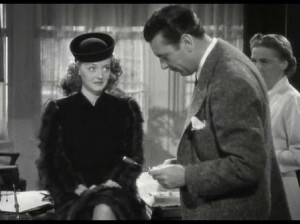 In that first-meeting examination, through a quickly realized doctor/patient bond, he is so good a brain specialist that he simultaneously diagnoses her—without the x-rays of the time or, if he had had them available, CT scans or MRIs. Today’s doctors would automatically order a battery of tests before any bedside manner was established. The doctor talk in Dark Victory is unusually profuse and technical for the time, though unfortunately no brain tumor victim experiences the painless, predictable and punctual death which befalls Judith.
In that first-meeting examination, through a quickly realized doctor/patient bond, he is so good a brain specialist that he simultaneously diagnoses her—without the x-rays of the time or, if he had had them available, CT scans or MRIs. Today’s doctors would automatically order a battery of tests before any bedside manner was established. The doctor talk in Dark Victory is unusually profuse and technical for the time, though unfortunately no brain tumor victim experiences the painless, predictable and punctual death which befalls Judith.
Irish actress Geraldine Fitzgerald plays Ann, a kind of neutral reflector of Judith’s emotional temperature and temperament, a mediator between her friend and Dr. Steele, and a confidant of both. Two weeks before Dark Victory premiered, Fitzgerald had made her Hollywood début in Wuthering Heights and was nominated Best Supporting Actress, along with Olivia de Havilland and Hattie McDaniel, both for Gone With the Wind. McDaniel was the winner.
Davis and Fitzgerald met for the first time during the Dark Victory filming and would become fast friends, or, more accurately, Geraldine would become Bette’s friend, the first hurdle in any Davis relationship. In fact, because of the camaraderie, only increased now with the Irish lass’s presence, things were more congenial than on most Davis sets, here without a [intlink id=”1225″ type=”category”]Joan Crawford[/intlink] or an [intlink id=”34″ type=”category”]Errol Flynn[/intlink] to incense her.
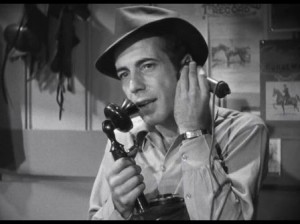 Everyone plays second fiddle to Bette, more so than usual in this picture, and the rest of the supporting cast includes a pre-Maltese Falcon, pre-Casablanca [intlink id=”125″ type=”category”]Humphrey Bogart[/intlink] Bogart as a miscast Irish horse trainer, complete with an Irish brogue. Some critics think he distinguishes himself, especially compared with his then current gangster image. Davis herself is all appreciation “for the help his performance gave me in playing mine.” She was perhaps thinking, primarily, of his strong support in the stable scene when she announces, “I’m going to die, Michael.”
Everyone plays second fiddle to Bette, more so than usual in this picture, and the rest of the supporting cast includes a pre-Maltese Falcon, pre-Casablanca [intlink id=”125″ type=”category”]Humphrey Bogart[/intlink] Bogart as a miscast Irish horse trainer, complete with an Irish brogue. Some critics think he distinguishes himself, especially compared with his then current gangster image. Davis herself is all appreciation “for the help his performance gave me in playing mine.” She was perhaps thinking, primarily, of his strong support in the stable scene when she announces, “I’m going to die, Michael.”
Ronald Reagan has a one-note role as an always drunk suitor of Judith’s, Henry Travers is the concerned doctor who delivered her, Cora Witherspoon an unnecessary fellow socialite who pops in from time to time, Dorothy Peterson Dr. Steele’s nurse and Virginia Brissac Judith’s compassionate housekeeper, the recipient of Davis’ last line in the film: “I don’t want to be disturbed.”
Frank S. Nugent, a New York Times critic of the day, second only to Bosley Crowther in readership, wrote in April of 1939, “Miss Davis is superb. More than that, she is enchanted and enchanting. Admittedly, it is a great role—rangy, full-bodied, designed for a virtuoso . . . But that must not detract from the eloquence, the tenderness, the heart-breaking sincerity with which she has played it.”
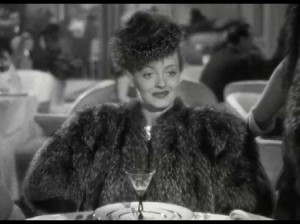 Bette Davis was, indeed, on the crest of her career in this year of years. Sure, there were triumphs to come—The Letter, The Little Foxes, Now, Voyager and, last in this class, All About Eve. But there would be future films unsuited to her strengths—The Bride Came C.O.D. and The Man Who Came to Dinner—and then troubled signs, as early as the late ’40s, of miscasting and poor pictures—Winter Meeting and Beyond the Forest. And then, finally, as happens to so many of those Hollywood glamour queens, the descent into trash, the grotesque and, ultimately, with no holds barred, Grand Guignol: Dead Ringer, What Ever Happened to Baby Jane?, Hush . . . Hush, Sweet Charlotte and The Anniversary.
Bette Davis was, indeed, on the crest of her career in this year of years. Sure, there were triumphs to come—The Letter, The Little Foxes, Now, Voyager and, last in this class, All About Eve. But there would be future films unsuited to her strengths—The Bride Came C.O.D. and The Man Who Came to Dinner—and then troubled signs, as early as the late ’40s, of miscasting and poor pictures—Winter Meeting and Beyond the Forest. And then, finally, as happens to so many of those Hollywood glamour queens, the descent into trash, the grotesque and, ultimately, with no holds barred, Grand Guignol: Dead Ringer, What Ever Happened to Baby Jane?, Hush . . . Hush, Sweet Charlotte and The Anniversary.
Although Bette was frail and gaunt in her next-to-last picture, The Whales of August (1987; she would die October 6, 1989), she was joined by Lillian Gish, Vincent Price, Harry Carey, Jr. and Ann Sothern, a seasoned cast. Like characters Bette had often played before, especially as her career progressed, Libby Strong is irascible and duplicitous, but a respectable film had returned, one she was undoubtedly proud of, and, along with it, a certain amount of acclaim.